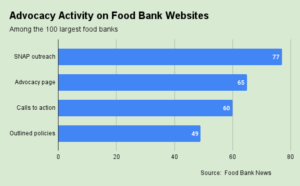The White House today released its national strategy for ending hunger and increasing healthy eating by 2030, one day ahead of its historic convening on hunger, nutrition and health. Here are ten things – relevant to the hunger-relief sector – that caught our eye.
- The Administration is embracing school meals. It wants to reorient the program from “an ancillary service to an integral component of the school day,” and sees integrating scratch-cooked meals featuring local food as integral to its approach. Its first step is to work with Congress to expand access to free school meals to 9 million additional kids by 2032 (up from 30 million currently). In addition, it acknowledges it will “continue to support an expansion of Summer EBT” so kids have access to healthy meals during the summer months as well.
- It wants to expand SNAP eligibility to cover additional populations, and specifically identified formerly incarcerated individuals, people living in U.S. territories, college students, and youth who have aged out of foster care. (It did not mention undocumented individuals, which happen to be the focus of California’s Food4All initiative, making California the first state to provide food assistance to undocumented adults 55 and older.)
- Mention of food banking turned up with respect to hospitals and housing. The Administration wants to give incentives to hospitals and public housing authorities to put food pantries and/or summer meal services on their premises.
- The Administration also wants to make food insecurity screenings standard within health care settings, in part by creating incentives for health care providers to do the screenings.
- It wants to take advantage of community groups and community programs to strengthen food access. This is in keeping with a growing tendency by food banks to seek out partnerships with community groups that have deep connections with underserved populations.
- It wants to reduce food waste and encourage food recovery by getting several government agencies involved in developing a strategy.
- It wants to get better at providing emergency food by simplifying TEFAP, providing more culturally relevant food, and getting FEMA involved in assuring food security during disasters.
- It wants to expand the use of SNAP incentives to increase fruit and vegetable purchasing.
- It wants to invest in local and regional food hubs and food processing facilities so food banks and schools can provide more nutritious food to underserved communities.
- It wants the Bureau of Prisons to work with the USDA to support gardening programs in which incarcerated people grow and harvest produce that is donated to local food banks.
Like what you’re reading?
Support Food Bank News
This article was made possible by the readers who support Food Bank News, a national, editorially independent, nonprofit media organization. Food Bank News is not funded by any government agencies, nor is it part of a larger association or corporation. Your support helps ensure our continued solutions-oriented coverage of best practices in hunger relief. Thank you!
Connect with Us:





